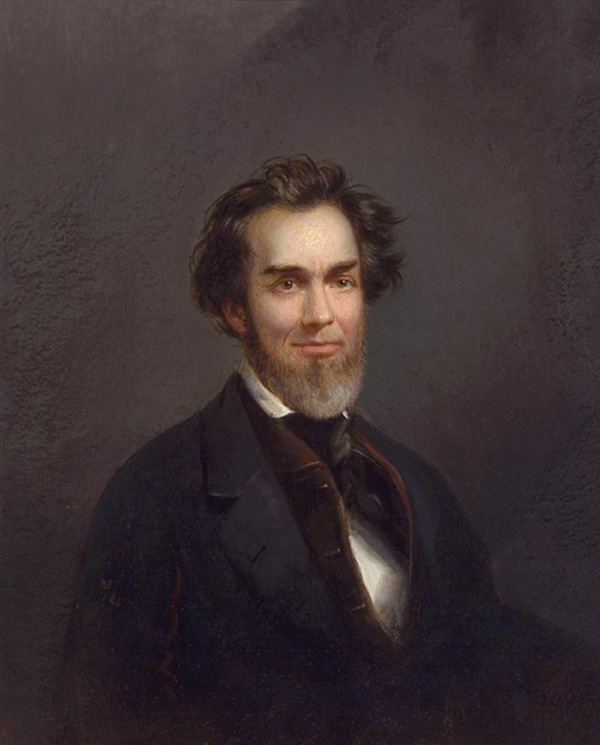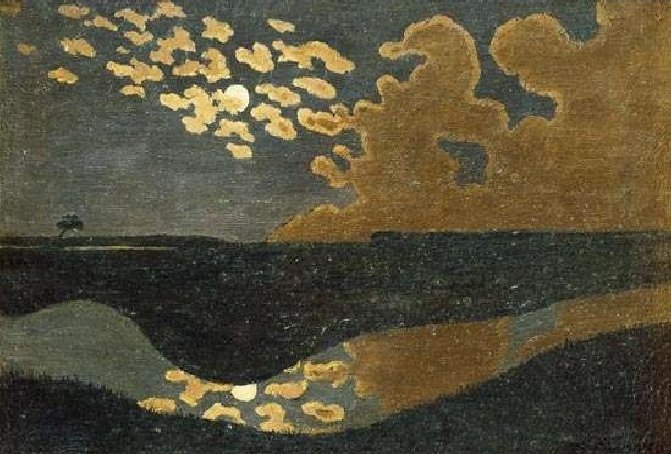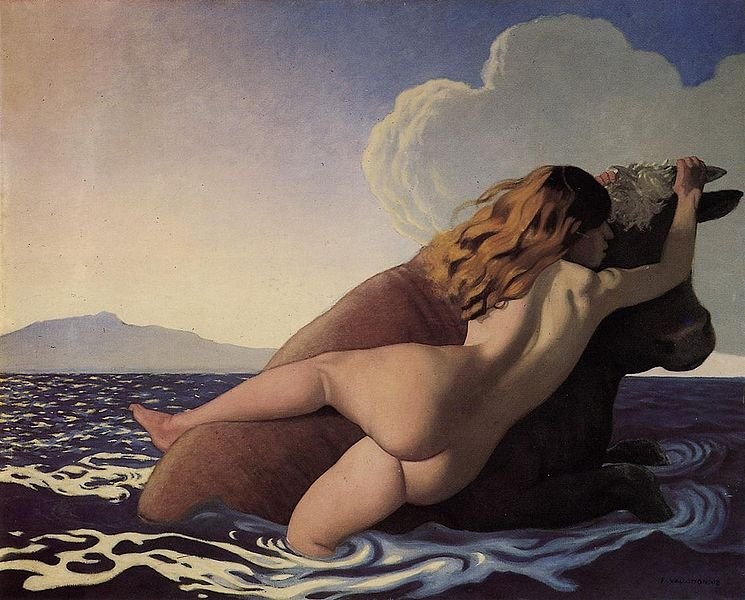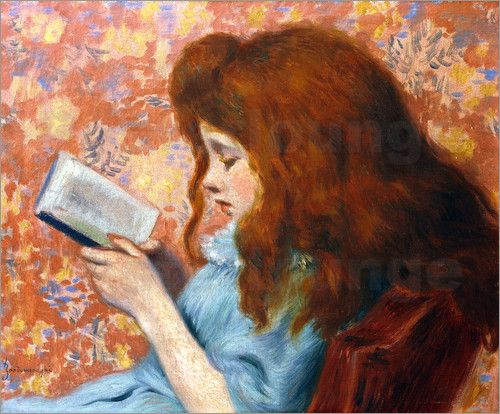
It is often strange that a chance meeting or a chance happening can affect one’s life but for my featured artist today his life was changed when he met a man who offered him a chance to go on a “holiday adventure”. Intrigued? Then come and join me as I look at the life of the nineteenth century American painter Alfred Jacob Miller and explore the world of mountain men and the famous rendezvous of trappers.
Miller was born in Baltimore, Maryland on January 2, 1810. Like many artists I have featured, as a child, he loved to paint and sketch. Apparently when he was at school he loved to create caricatures of his teachers which often got him into trouble. It is said that his first art lessons were given to him by the talented American portrait painter, Thomas Sully in Philadelphia.

Miller worked on his portraiture and an example of this early work can be seen in his companion pieces Portrait of Colonel Alexander Smith and his wife Portrait of Lydia Lloyd Murray which he was commissioned to paint in 1833.

Colonel Alexander Smith served in the Morgan Volunteers which was a militia based in Baltimore part of the Maryland militia, a group of men which is probably the equivalent of the current National Guard. Colonel Smith paid Miller $75 for the pair of paintings. The two paintings are now housed in the Walters Museum in Baltimore.
Little is known about Miller’s early years except that his talent as an aspiring artist was blossoming. In his 1832 book Six Months in America, the seasoned traveller and travel writer, Godfrey Vigne wrote:
“…At Baltimore I visited the studies of two very promising young artists: Mr Hubbard, an Englishman, is certainly the better painter; but has the advantage of four or five years of experience over Mr Miller, who is an American , quite a boy; and whom, I think, at least an equal genius. He has had little or no instruction. If sent to Europe as he certainly ought to be, I will venture to predict, that at some future period he will be an ornament to his native city; and which he certainly never will, or can be, if he does not leave it…”
Whether or not Vigne spoke to Miller about the advantages of travelling to Europe to study art is not known but it is quite likely. The seeds must have been planted in Miller’s mind for in 1833, at the age of twenty-three, with the financial backing of his parents, he did leave the shores of America and head for Europe in order to enhance his knowledge of his true love, art. Whilst in Europe, he visited Switzerland, the Italian cities of Bologna, and Rome where he studied religious art at the Gallerie Borghese. He also made many sketching trips through the Lazio region, north of the Italian capital, Venice and spent a considerable amount of time in Paris, where he attended life classes at the École des Beaux Arts. During his stay in the French capital, Miller like other visiting painters would spend time at the Louvre and other galleries copying the works of the Old Masters.

Miller loved to sketch, in fact he was a prolific sketcher and filled many sketchbooks with his sketches, most of which were accompanied by his own captions. Above the sketch, Baltimore Watchman, on which, he scribbled in pencil:
“…Recollections” and “One of the Dogberry’s of 1825 Balto”.
Below the figure he scrawled:
“…”after crying the hour of ten, he slept soundly in his box– until roused again…”

Many of his sketches depicted theatre life but also life in the home. One poignant sketch of his was entitled The Two Friends.

Another moving sketch was entitled Bridge of Sighs which shows a woman committing suicide by jumping from a bridge. Miller’s scribbled notes at the bottom of the sketch are a quote from the Thomas Hood 1844 poem Bridge of Sighs:
“…It was pitiful, near a whole city full, Friend, had she non….”
Thomas Hood’s poem also inspired the English painter, George Frederick Watts to complete his moving 1850 painting, Found Drowned (see My Daily Art Display, July 4th 2011)
Miller returned to Baltimore in 1834 and opened his own portrait studio but his portrait business was poor and so, in December 1836, he decided to relocate to New Orleans and ply his trade in that city. Miller set up lodgings on the second floor of L. Chittenden’s dry-goods store on Chartres Street in New Orleans. This also acted as his studio. However, money was still tight as his optimism that commissions would soon roll in was unfounded and his financial plight was such that he painted the landlord’s portrait in lieu of his rent. In return his landlord also allowed Miller to place some of his works of art in the shop window. Maybe this was fate for Miller’s artwork attracted a passer-by who came into the shop and watched Miller at work. The man was Captain William Drummond Stewart. He was the second son of Sir George Stewart, seventeenth Lord of Grandtully and fifth baronet of Murthly. William Stewart was a Scottish adventurer and retired British military officer, who had travelled around the American West in the 1830’s. He told Miller that he was about to set off to attend the annual rendezvous of fur trappers and traders in the Rocky Mountains in the summer and needed an artist to accompany him and record the trip.

Miller’s painting Attack by Crow Indians has a fascinating story to go with it. Miller did not witness the scene himself, which happened during an earlier expedition of Captain Stewart’s who then recounted the story to Miller who converted his words into a painting.. In fact Miller made a number of versions of Stewart’s story. The account of the story appears in the book entitled Broken Hand by LeRoy Hafen. In it he tells of what happened a century earlier:
“…a band of young Crows invaded the camp while Fitzpatrick was away and Stewart was in charge. They carried off stock, pelts, and other property. They encountered Fitzpatrick on their return and stripped him of everything of value as well. As Stewart described the incident, the Crow medicine man had told the braves that, if they struck the first blow, they could not win. Thus, they had to provoke Stewart or someone in his party into striking the first blow. Stewart stood firm, refusing to strike. The Crows left, and the captain survived a situation in which he would have surely lost the battle. Fitzpatrick managed to talk the Crows into returning most of what they had taken…”
——————————————————————
These annual Rocky Mountain Rendezvous, which began in 1822 and went on for fifteen years, happened in various locations during the spring and early summer months. The rendezvous was originally organised by a St. Louis businessman and politician William H. Ashley. The idea was that the trappers, who lived in the wild collecting furs, would not have to leave the mountains to come to the cities to sell or exchange their wares for much needed rations but would instead exchange their produce at an annual fair in the mountain regions. Ashley advertised for men who were willing to seek adventure as trappers and stay in the mountainous wilderness for up to two or three years.

These “Rendezvous” were a kind of trading fair organised by the fur trading companies at which the trappers and so-called mountain men would exchange their furs and hides, which they had collected during the year, for supplies which would allow them to survive the harsh winters. The fur trading companies would then move the furs and hides to places in the Pacific Northwest or the ports on the northern Missouri river. It was a time of celebration when the trappers and their wives and children as well as Native Indians would come to the Rendezvous after a long season of hunting. The fur trading companies, as well as bringing food, weapons and ammunition, would also bring whisky which no doubt enhanced the celebrations. The trapper and mountain man, James Pierson Beckwourth, who narrated his life story, which was then made into a book in 1856 entitled The Life and Adventures of James P. Beckwourth: Mountaineer, Scout and Pioneer, and Chief of the Crow Nation of Indians, told of the merriment:
“…“Mirth, songs, dancing, shouting, trading, running, jumping, singing, racing, target-shooting, yarns, frolic, with all sorts of extravagances that white men or Indians could invent…”

William Stewart had been present at four previous rendezvous but due to the failing health of his brother , the then lord of Grandtully and baronet of Murthly, he had an inclination that this 1837 one maybe his last and so believed that the event should be recorded pictorially by an artist – hence Alfred Jacob Miller. Miller also knew he had little to lose by leaving New Orleans and so readily agreed to take part in the adventure. The Rendezvous in the spring of 1837 was to take place on the banks of the tributary of the Green River an area which is at the centre of the Rocky Mountain region and is now part of Wyoming. Stewart, Miller, representatives from the American Fur Company and the caravan of goods set off for St Louis in April 1837. On arriving at St Louis, William Stewart introduced Alfred Miller to Governor William Clark, an American explorer, soldier, Superintendant of Indian Affairs and territorial governor. His collection of artefacts and paintings by George Catlin, who was an American painter, author, and traveller who specialized in portraits of native Americans in the Old West. They had a great influence on Miller. From St Louis the fur company’s caravan headed across what is now known as Kansas and finally arrived at the Platte River. From there they headed into western Wyoming and finally arrived at their destination, the valley Horse Creek with its backdrop of the Wind River Mountains part of the Rocky Mountain range.

Throughout the journey Miller was continuously sketching the exquisite mountainous terrain, the people who were part of the caravan and of course the mountain men and Indians who had come to exchange their furs and hides. At the rendezvous site the fur trappers and Indians were eagerly awaiting the arrival of the Fur Company’s caravan. These people made excellent sitters for Miller’s portraits. One such person whose portrait Miller completed was Antoine Clement who had been one of the scouts and buffalo hunters who had supplied the people on the travelling caravan with food during their journey. Clement was a half caste, his father was French, his mother a native Indian. All in all Miller’s stay at Horse Creek lasted three weeks and then after two weeks on a hunting trip with William Stewart they returned to New Orleans.

One painting Miller converted from one of his sketches was The Lost Greenhorn. The story behind the painting was given in Miller’s 1837 book entitled The West of Alfred Jacob Miller:
“…On reaching the Buffalo District, one of our young men began to be ambitious, and although it was his first journey, boasted continually of what he would do in hunting Buffalo if permitted. This was John (our cook), he was an Englishman and did no discredit to that illustrious nation in his stupid conceit and wrong-headed obstinacy. Our Captain, when any one boasted, put them to the test, so a day was given to John and he started off early alone. The day passed over, night came, – but so did not John. Another day rolled over, the hunters returning at evening without having met him. The next morning men were dispatched in different quarters, and at about two o’clock, one of the parties brought in the wanderer – crest fallen and nearly starved;- he was met by a storm of ridicule and roasted on every side by the Trappers. Thus carrying out that ugly maxim of Rochefoucault’s ‘There is always something in the misfortune of our friends not disagreeable to us’…”‘

Once back in the Louisiana city Miller set to work on his large collection of sketches he had made whilst at the rendezvous and completed an album of eighty seven of the watercolour sketches. William Thompson Walters, an American businessman and art collector, whose collection was to form the basis of the Walters Art Museum in Baltimore where many of Miller’s paintings are housed, commissioned two hundred watercolours from Miller paying him twelve dollars per painting. Each sketch was accompanied by Miller’s descriptive text. It took Alfred Miller almost two years to complete the commission which William Walters then had bound in three leather volumes.

Miller was interested in the lifestyle of the Native Americans and his painting entitled Indian Lodge looks at the Indian lodge and its construction with its upright supports which act to hold the supporting bond timbers at differing heights and this design allows for a sloping circular roof. There is an aperture at the centre of the roof which allows light to filter in and allows smoke from the fires to exit the space. The painting depicts groups of Indians scattered around the large space, some standing, some seated some immersed in game playing.
William Stewart returned to the Rocky Mountains for the 1838 Rendezvous but whilst there he learnt of the death of his brother back in Scotland. William Stewart had suddenly become the new laird of the family’s estates of Murthly, Grandtully, and Logiealmond. Stewart, now Sir William Stewart, returned home to Scotland and commissioned Alfred Miller to paint a series of large oil paintings which would be on display at Murthly Castle. In 1840, Miller was invited to stay at Murthly Castle by its new owner and whilst there he could continue with his paintings. He accepted the invite and was Sir William’s guest until the autumn of 1841 at which time he returned to Baltimore where he was to live the rest of his life and where he established himself as a leading portraitist of the time.
After his 1837 Rendezvous expedition, Miller worked for many years converting many of his two hundred sketches he had made whilst out West into oil paintings. The public loved them and he received many commissions. He also sold several of his works of art to Charles Wilkins Webber, the American explorer and writer who had them made into illustrations for his 1851 book The Hunter-Naturalist: Romance of Sporting; or, Wild Scenes and Wild Hunters.
In 1839 the Apollo Gallery in New York held an exhibition featuring eighteen of Miller’s large oil paintings depicting scenes from his 1837 expedition with Stewart. The paintings were owned by Stewart who agreed to loan them to the gallery. So popular was the exhibition that it was extended to allow more people to view Miller’s work.
Alfred Jacob Miller spent the next thirty years working hard on converting his sketches into oil paintings to satisfy all the commissions he received. He also continued with his portraiture work. He is now looked upon as one of the earliest and most significant painters to record pictorially the American West. He was the only artist to go on a Rendezvous expedition and depict the fur traders, Native Indians and mountain men. His art played a major role in educating people back East about life in the American West.
Alfred Jacob Miller died in Baltimore in June 1874, aged sixty-four.

I am going to conclude this blog with one of my favourite paintings of his. It is not an American West landscape nor is it one of the mountain men or Native Americans. It is a painting he completed around 1840 entitled Artist’s Studio – The Critic and in some way it is an amusing look at a cleaner who is appraising a painting which is in the studio of an artist in which she is the cleaner. We see her pausing from sweeping the floor to look at a painting on the easel.
If you live near Baltimore and like what I have shown you it would be worth visiting the Walters Art Museum on Charles Street. I would be interested to hear what you thought of the collection of Miller’s artwork.




































